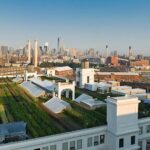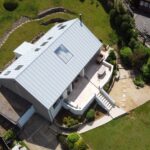Green roofs transform urban living spaces, Eco building roofing, Ecological property design
Green Roofs Transform Urban Living Spaces
24 April 2024
In the heart of bustling cities, where space is at a premium and the environment begs for a touch of green, urban planners and architects are increasingly turning their gazes upward. Green roofs, those verdant sanctuaries set high above the concrete sprawl, not only beautify our urban landscapes but also deliver substantial environmental benefits. Just as playing Balloon money game layers engaging visuals and strategies for a captivating online experience, architects layer soil, vegetation, and waterproofing systems to transform barren rooftops into thriving ecosystems.
This innovative approach to urban architecture not only maximizes the use of space but also highlights the potential to reimagine and enrich our cityscapes profoundly. By integrating these living systems into the fabric of urban life, green roofs create a symbiotic relationship between nature and the built environment, promising a greener, more sustainable future for urban dwellers.
Benefits and Impact on Urban Life
Green roofs have proven to be more than just aesthetically pleasing additions to urban buildings. They contribute significantly to the ecological and social fabric of cities.
By installing green roofs, buildings reduce their energy consumption markedly, thanks to the added insulation that helps maintain a consistent internal temperature, lessening the reliance on heating and cooling systems. Moreover, these living roofs play a critical role in stormwater management. They absorb and retain rainwater, thus alleviating the burden on urban drainage systems and reducing the risk of flooding.
Health and wellness benefits are profound as well. Green roofs can improve air quality by filtering pollutants and carbon dioxide out of the air, which is a boon for urban areas where air quality can often be a concern. They also mitigate the urban heat island effect, a phenomenon where city regions become significantly warmer than their rural surroundings, primarily due to human activities.
Architectural and Design Considerations
Implementing a green roof requires thoughtful design and careful consideration of several factors to ensure its success and longevity. Below is a step-by-step approach to designing a functional green roof:
- Assessment of Structural Integrity. Buildings must be evaluated to ensure that they can support the additional weight of a green roof, which includes the substrate, plants, and retained water.
- Waterproofing and Root Repellant Layer Installation. This is crucial to prevent water leakage into the building and protect the structure from root penetration.
- Drainage System Design. Adequate drainage is essential to prevent water accumulation and ensure the roof’s structural integrity.
- Choice of Green Roof Type. Options range from extensive roofs, which are lightweight and require minimal maintenance, to intensive roofs, which can support a wider variety of plants but are heavier and need more maintenance.
- Selection of Flora. The choice of plants should consider the climate, roof conditions, and the amount of maintenance required.
By adhering to these guidelines, architects and builders can maximize the efficacy and benefits of green roofs.
Case Studies of Successful Green Roof Projects
Examining successful green roof projects provides insights into their practical implementation and benefits. Here are a few notable examples:
- The Ford Dearborn Truck Plant. This facility in Michigan features a 10.4-acre living roof, one of the largest in the world, which has helped to significantly reduce stormwater runoff and decrease the building’s energy usage.
- Chicago City Hall. An extensive green roof, which is not only a testbed for evaluating the impact of green roofs on temperature and air quality but also serves as a key element in Chicago’s Urban Heat Island Initiative.
- Vancouver Convention Center. This waterfront facility boasts a six-acre living roof, the largest in Canada, which hosts some 400,000 indigenous plants and provides a habitat for bees, birds, and butterflies.
Future Trends in Green Roof Architecture
The future of green roofing promises exciting innovations and broader adoption as its benefits become more widely recognized and technologies advance. Key trends include the integration of solar panels with green roofs, creating dual-purpose spaces that enhance energy efficiency while also supporting plant life. Another emerging trend is the use of smart monitoring technologies that can track the health and performance of green roofs, providing real-time data to optimize maintenance and water usage.
As urban populations continue to grow, the implementation of green roofs could become a standard feature of building design, rather than an exception. The potential for these spaces to transform urban living is immense, offering a patchwork of green hubs across the urban skyline.
Building Eco Roofing Conclusion
Green roofs represent a synthesis of nature and urban living, illustrating how cities can expand upwardly without losing touch with environmental consciousness. They provide critical ecosystem services, enhance the livability of urban environments, and offer an aesthetic appeal that enriches the human experience in cities.
As the world continues to urbanize, green roofs stand as a testament to innovative architectural practices that harmonize urban development with ecological stewardship, heralding a greener, more sustainable future for all urban dwellers.
Comments on this guide to Green Roofs Transform Urban Living Spaces article are welcome.
Architecture Design
Contemporary Building Designs – recent architectural selection from e-architect below:
Buildings
Contemporary Property Articles – recent architectural selection from e-architect below:
London Architecture Designs – chronological list
Comments / photos for the Green Roofs Transform Urban Living Spaces page welcome.





